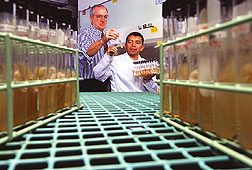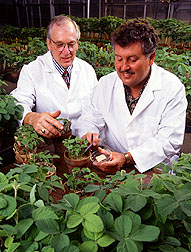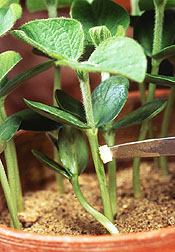Holding Soy Fungi at Bay
Phytophthora infestans, the fungus infamous for causing the Irish potato famine, has a form called Phytophthora sojae that attacks soybeans.
And this one is bad news, too. It causes one of the most serious diseases of soybeans in the United States, Phytophthora root rot.
P. sojae actually attacks soybeans at all growth stages. In seedlings, it causes rotting of the stem, called damping-off. Later, it causes the stem and lower branches to turn brown, while leaves turn yellow and wilt. During the growing cycle, it may also invade roots and lower yields without showing any visible above ground symptoms.
After 30 years of investigations, Agricultural Research Service plant pathologist T. Scott Abney has become an expert on combating Phytophthora, as well as another soybean disease, sudden death syndrome (SDS). Thanks to his research on the genetics and virulence of fungal pathogens, the arsenal of weapons available to fight these enemies has increased substantially over the past few years.
Says Abney, "Far more diverse types of fungal pathogens attack soybean seedlings, roots, and shoots than were known previously. Some work together regularly, infecting plants, reducing their growth, and lowering yields.
"Once damaged," he says, "weakened plants become susceptible to more pests."
One of Abney's tactics is to find out how host plants and fungal parasites interact and how much inherent disease resistance soybeans have for their defense. Most have some form of natural resistance, so yield losses of about 25 percent or 10 bushels per acre are more common than total crop failure.
Abney has focused major attention on the Phytophthora fungus and the soybean genes called Rps.
"These genes trigger the production of an antifungal compound phytoalexin that protects the plant from the fungus," he says. "Once soybeans with specific Rps genes that resist the new Phytophthora races are identified, public and private soybean breeders can use them to develop commercial soybeans with improved resistance to Phytophthora root rot."
Since 1955 when Phytophthora root rot was first documented in the United States, 14 resistance genes and more than 40 races of the fungal pathogen have been identified. Abney's research goals with Phytophthora are to document the status of Phytophthora races in soybean production areas and to develop more effective screening techniques to improve the efficiency of identifying which race or races is infecting plants.
To describe the races of Phytophthora found in U.S. soils, Abney collects diseased plants and soil samples from soybean fields. Back in the lab, he cultures the fungi isolated from the plant and soil samples. Then he inoculates them into soybean seed lings representing different Rps genes to identify the race of P. sojae.
"Disease reactions of these soybean varieties are the only way we can identify races of the fungus and predict what regions of the state different races will occur in," he says.
Abney's work on determining the prevalence and severity of the fungus led to his discovery and identification of several new races of P. sojaesuggesting that genetic diversity among populations of this pathogen is much greater than previously thought.
"Phytophthora root rot is more widespread in Indiana and other midwestern and southern states than expected," says Abney. In the early 1990s, 13 of the 27 known races were in Indiana. Abney identified seven additional races in 1993 and 1994 and is currently confirming the existence of several more.
|
|
Working with Mississippi State University scientist Kenneth W. Roy, Abney found that Fusarium solani and another form, F. oxysporum, were the most frequently isolated pathogens of soybean seedlings and mature plants.
"We also found that the highly pathogenic form A of F. solani that causes SDS did not differ between southern- and northern-grown soybeans," Abney says.
When they examined plants from soybean fields in Arkansas, Illinois, Indiana, Kentucky, and Mississippi to determine the incidence and geographic distribution of F. solani in roots of older plants, Abney and Roy discovered that form B, differing from form A in spore-producing characteristics was found most often and was widely distributed geographically.
Additional SDS research involving selected soybean varieties and diverse germplasm sources showed that
germplasm resistant to soybean cyst nematodes (SCN) the P.I. 437654 extensively used in breeding programs is super-susceptible to SDS.
"Awareness of this SDS reaction and selection of progeny that are not highly susceptible to SDS will permit researchers to reduce the genetic vulnerability of soybeans to both SCN and SDS," says Abney. "Knowledge of pathogen variability and host vulnerability to SDS is leading to more effective control of this new disease of soybeans."
As a member of the ARS-Purdue University soybean improvement team, Abney has collaborated with colleague James R. Wilcox, an ARS geneticist at the West Lafayette, Indiana, laboratory, to develop and release 14 soybean varieties with improved disease resistance.
For all his pioneering work on soybean diseases, Abney was recently commended by the Soybean Development Council's research committee.
Charles Noble, a member of the committee and a soybean farmer in Daviess County, Indiana, says, "I'm pleased with Abney's work and his commitment to Indiana soybean farmers. His research, which is funded in part by the council, is used by a lot of seed companies, and that's helping us producers get more from our seed investment."
For his outstanding research contribution to U.S. soybean producers, Abney was awarded the production research award by the American Soybean Association in 1995. — By Hank Becker.
T. Scott Abney is in the USDA-ARS Crop Production and Pest Control Research Unit, Purdue University, West Lafayette, IN 47907; phone (765) 494-9859









